CuxO Nanostructure-Based Gas Sensors for H2S Detection: An Overview
Abstract
:1. Overview of H2S Gas Properties
2. Motivation for the Use of CuxO as a H2S Gas Sensor
3. Gas Sensors Based on Pristine CuxO Nanostructures
4. Pd-Decorated/Doped CuxO Nanostructure-Based Gas Sensors
5. CuxO Nanocomposite-Based Gas Sensors
6. Comparison of Different CuO-Based Gas Sensors
7. Conclusions
Author Contributions
Funding
Institutional Review Board Statement
Informed Consent Statement
Data Availability Statement
Acknowledgments
Conflicts of Interest
References
- Hu, Y.; Li, L.; Zhang, L.; Lv, Y. Dielectric barrier discharge plasma-assisted fabrication of g-C3N4-Mn3O4 composite for high-performance cataluminescence H2S gas sensor. Sens. Actuators B Chem. 2017, 239, 1177–1184. [Google Scholar] [CrossRef]
- Li, H.; Liu, T.; Su, S.; Jin, M.; Fang, W.; Liu, L.; Wang, Y.; Hu, S.; Xiang, J. Effect of Ce modification on desulfurization per-formance of regenerated sorbent for high temperature H2S removal from coal gas. Fuel 2021, 293, 120463. [Google Scholar] [CrossRef]
- Abdel Rahman, N.S.; Greish, Y.E.; Mahmoud, S.T.; Qamhieh, N.N.; El-Maghraby, H.F.; Zeze, D. Fabrication and characteri-zation of cellulose acetate-based nanofibers and nanofilms for H2S gas sensing application. Carbohydr. Polym. 2021, 258, 117643. [Google Scholar] [CrossRef]
- Mirzaei, A.; Kim, S.S.; Kim, H.W. Resistance-based H2S gas sensors using metal oxide nanostructures: A review of recent advances. J. Hazard. Mater. 2018, 357, 314–331. [Google Scholar] [CrossRef] [PubMed]
- Zheng, D.; Jiang, Z.; Shi, J.; Wang, Y.; Liu, Z. Experimental analysis of the effect of nitrogen gas on the H2S stripping process during the pigging operation of a long crude oil pipeline. Case Stud. Therm. Eng. 2020, 22, 100741. [Google Scholar] [CrossRef]
- Hoa, T.T.N.; Le, D.T.T.; Van Toan, N.; Van Duy, N.; Hung, C.M.; Van Hieu, N.; Hoa, N.D. Highly selective H2S gas sensor based on WO3-coated SnO2 nanowires. Mater. Today Commun. 2021, 26, 102094. [Google Scholar] [CrossRef]
- Ho, D.M.; Ho, B.Q.; Le, T.V. Evaluate of air pollution dispersion and propose planing scenerios to reduce air pollution for livestock activities in Tan Thanh district, Ba Ria—Vung Tau province. Sci. Technol. Dev. J. Sci. Earth Environ. 2019, 2, 26–37. [Google Scholar] [CrossRef]
- Asad, M.; Sheikhi, M.H.; Pourfath, M.; Moradi, M. High sensitive and selective flexible H2S gas sensors based on Cu nanoparticle decorated SWCNTs. Sens. Actuators B Chem. 2015, 210, 1–8. [Google Scholar] [CrossRef]
- Padua, L.M.G.; Yeh, J.-M.; Santiago, K.S. A Novel Application of Electroactive Polyimide Doped with Gold Nanoparticles: As a Chemiresistor Sensor for Hydrogen Sulfide Gas. Polymers 2019, 11, 1918. [Google Scholar] [CrossRef] [Green Version]
- Somacescu, S.; Stanoiu, A.; Dinu, I.V.; Calderon-Moreno, J.M.; Florea, O.G.; Florea, M.; Osiceanu, P.; Simion, C.E. CuWO4 with CuO and Cu(OH)2 native surface layers for H2S detection under in-field conditions. Materials 2021, 14, 465. [Google Scholar] [CrossRef]
- Hsu, K.-C.; Fang, T.-H.; Hsiao, Y.-J.; Li, Z.-J. Rapid detection of low concentrations of H2S using CuO-doped ZnO nanofibers. J. Alloy. Compd. 2021, 852, 157014. [Google Scholar] [CrossRef]
- Peng, F.; Sun, Y.; Lu, Y.; Yu, W.; Ge, M.; Shi, J.; Cong, R.; Hao, J.; Dai, N. Studies on Sensing Properties and Mechanism of CuO Nanoparticles to H2S Gas. Nanomaterials 2020, 10, 774. [Google Scholar] [CrossRef] [PubMed]
- Ali, F.I.M.; Mahmoud, S.T.; Awwad, F.; Greish, Y.E.; Abu-Hani, A.F.S. Low power consumption and fast response H2S gas sensor based on a chitosan-CuO hybrid nanocomposite thin film. Carbohydr. Polym. 2020, 236, 116064. [Google Scholar] [CrossRef] [PubMed]
- Hittini, W.; Abu-Hani, A.F.; Reddy, N.; Mahmoud, S.T. Cellulose-Copper Oxide hybrid nanocomposites membranes for H2S gas detection at low temperatures. Sci. Rep. 2020, 10, 1–9. [Google Scholar] [CrossRef] [Green Version]
- Pravarthana, N.D.; Tyagi, A.; Jagadale, T.C.; Prellier, W.; Aswal, D.K. Highly sensitive and selective H2S gas sensor based on TiO2 thin films. Appl. Surf. Sci. 2021, 549, 149281. [Google Scholar] [CrossRef]
- Mokoena, T.P.; Tshabalala, Z.P.; Hillie, K.T.; Swart, H.C.; Motaung, D.E. The blue luminescence of p-type NiO nanostructured material induced by defects: H2S gas sensing characteristics at a relatively low operating temperature. Appl. Surf. Sci. 2020, 525, 146002. [Google Scholar] [CrossRef]
- Tang, Y.; Wu, W.; Wang, B.; Dai, X.; Xie, W.; Yang, Y.; Zhang, R.; Shi, X.; Zhu, H.; Luo, J.; et al. H2S gas sensing performance and mechanisms using CuO-Al2O3 composite films based on both surface acoustic wave and chemire-sistor techniques. Sens. Actuators B Chem. 2020, 325, 128742. [Google Scholar] [CrossRef]
- Wu, Y.-Y.; Song, B.-Y.; Zhang, X.-F.; Deng, Z.-P.; Huo, L.-H.; Gao, S. Microtubular α-Fe2O3/Fe2(MoO4)3 heterostructure derived from absorbent cotton for enhanced ppb-level H2S gas-sensing performance. J. Alloy. Compd. 2021, 867, 158994. [Google Scholar] [CrossRef]
- El-Shamy, A.G. New nano-composite based on carbon dots (CDots) decorated magnesium oxide (MgO) nano-particles (CDots@MgO) sensor for high H2S gas sensitivity performance. Sens. Actuators B Chem. 2021, 329, 129154. [Google Scholar] [CrossRef]
- Yang, D.; Chen, G.; Fu, J.; Zhu, Y.; Dai, Z.; Wu, L.; Liu, J. The mitigation performance of ventilation on the accident consequences of H2S-containing natural gas release. Process Saf. Environ. Prot. 2021, 148, 1327–1336. [Google Scholar] [CrossRef]
- Yang, S.; Sun, J.; Xu, L.; Zhou, Q.; Chen, X.; Zhu, S.; Dong, B.; Lu, G.; Song, H. Au@ZnO functionalized three–dimensional macroporous WO3: A application of selective H2S gas sensor for exhaled breath biomarker detection. Sens. Actuators B Chem. 2020, 324, 128725. [Google Scholar] [CrossRef]
- Song, B.-Y.; Zhang, M.; Teng, Y.; Zhang, X.-F.; Deng, Z.-P.; Huo, L.-H.; Gao, S. Highly selective ppb-level H2S sensor for spendable detection of exhaled biomarker and pork freshness at low temperature: Mesoporous SnO2 hierarchical architectures derived from waste scallion root. Sens. Actuators B Chem. 2020, 307, 127662. [Google Scholar] [CrossRef]
- Pandey, S.K.; Kim, K.-H.; Tang, K.-T. A review of sensor-based methods for monitoring hydrogen sulfide. TrAC Trends Anal. Chem. 2012, 32, 87–99. [Google Scholar] [CrossRef]
- Vuong, N.M.; Chinh, N.D.; Huy, B.T.; Lee, Y.-I. CuO-Decorated ZnO hierarchical nanostructures as efficient and established sensing materials for H2S gas sensors. Sci. Rep. 2016, 6, 26736. [Google Scholar] [CrossRef] [Green Version]
- Ali, F.I.M.; Awwad, F.; Greish, Y.E.; Mahmoud, S.T. Hydrogen Sulfide (H2S) Gas Sensor: A Review. IEEE Sens. J. 2019, 19, 2394–2407. [Google Scholar] [CrossRef]
- Peng, F.; Sun, Y.; Yu, W.; Lu, Y.; Hao, J.; Cong, R.; Shi, J.; Ge, M.; Dai, N. Gas sensing performance and mechanism of CuO(p)-WO3(n) composites to H2S gas. Nanomaterials 2020, 10, 1162. [Google Scholar] [CrossRef] [PubMed]
- Kim, J.-Y.; Lee, J.-H.; Kim, J.-H.; Mirzaei, A.; Kim, H.W.; Kim, S.S. Realization of H2S sensing by Pd-functionalized networked CuO nanowires in self-heating mode. Sens. Actuators B Chem. 2019, 299, 126965. [Google Scholar] [CrossRef]
- Mirzaei, A.; Leonardi, S.G.; Neri, G. Detection of hazardous volatile organic compounds (VOCs) by metal oxide nanostruc-tures-based gas sensors: A review. Ceram. Int. 2016, 42, 15119–15141. [Google Scholar] [CrossRef]
- Mirzaei, A.; Neri, G. Microwave-assisted synthesis of metal oxide nanostructures for gas sensing application: A review. Sens. Actuators B Chem. 2016, 237, 749–775. [Google Scholar] [CrossRef]
- Nasri, A.; Pétrissans, M.; Fierro, V.; Celzard, A. Gas sensing based on organic composite materials: Review of sensor types, progresses and challenges. Mater. Sci. Semicond. Process. 2021, 128, 105744. [Google Scholar] [CrossRef]
- Ayesh, A.I.; Abu-Hani, A.F.; Mahmoud, S.T.; Haik, Y. Selective H2S sensor based on CuO nanoparticles embedded in organic membranes. Sens. Actuators B Chem. 2016, 231, 593–600. [Google Scholar] [CrossRef]
- Boepple, M.; Zhu, Z.; Hu, X.; Weimar, U.; Barsan, N. Impact of heterostructures on hydrogen sulfide sensing: Example of core-shell CuO/CuFe2O4 nanostructures. Sens. Actuators B Chem. 2020, 321, 128523. [Google Scholar] [CrossRef]
- Nadargi, D.Y.; Tamboli, M.S.; Patil, S.S.; Dateer, R.B.; Mulla, I.S.; Choi, H.; Suryavanshi, S.S. Microwave-Epoxide-Assisted Hydrothermal Synthesis of the CuO/ZnO Heterojunction: A Highly Versatile Route to Develop H2S Gas Sensors. ACS Omega 2020, 5, 8587–8595. [Google Scholar] [CrossRef] [Green Version]
- Paul, A.; Weinberger, C.; Tiemann, M.; Wagner, T. Copper Oxide/Silica Nanocomposites for Selective and Stable H2S Gas Detection. ACS Appl. Nano Mater. 2019, 2, 3335–3338. [Google Scholar] [CrossRef]
- Balsamo, M.; Cimino, S.; de Falco, G.; Erto, A.; Lisi, L. ZnO-CuO supported on activated carbon for H2S removal at room temperature. Chem. Eng. J. 2016, 304, 399–407. [Google Scholar] [CrossRef]
- Van Toan, N.; Hung, C.M.; Hoa, N.D.; Van Duy, N.; Le, D.T.T.; Viet, N.N.; Phuoc, P.H.; Van Hieu, N. Enhanced NH3 and H2 gas sensing with H2S gas interference using multilayer SnO2/Pt/WO3 nanofilms. J. Hazard. Mater. 2021, 412, 125181. [Google Scholar] [CrossRef] [PubMed]
- Hu, Q.; Zhang, W.; Wang, X.; Wang, Q.; Huang, B.; Li, Y.; Hua, X.; Liu, G.; Li, B.; Zhou, J.; et al. Binder-free CuO nanoneedle arrays based tube-type sensor for H2S gas sensing. Sens. Actuators B Chem. 2021, 326, 128993. [Google Scholar] [CrossRef]
- Huang, Z.; Wang, X.; Sun, F.; Fan, C.; Sun, Y.; Jia, F.; Yin, G.; Zhou, T.; Liu, B. Super response and selectivity to H2S at room temperature based on CuO nanomaterials prepared by seed-induced hydrothermal growth. Mater. Des. 2021, 201, 109507. [Google Scholar] [CrossRef]
- Miao, J.; Chen, C.; Lin, J.Y. Humidity independent hydrogen sulfide sensing response achieved with monolayer film of CuO nanosheets. Sens. Actuators B Chem. 2020, 309, 127785. [Google Scholar] [CrossRef]
- Dhakshinamoorthy, J.; Pullithadathil, B. New Insights Towards Electron Transport Mechanism of Highly Efficient p-Type CuO (111) Nanocuboids-Based H2S Gas Sensor. J. Phys. Chem. C 2016, 120, 4087–4096. [Google Scholar] [CrossRef]
- Zhang, F.; Zhu, A.; Luo, Y.; Tian, Y.; Yang, J.; Qin, Y. CuO Nanosheets for Sensitive and Selective Determination of H2S with High Recovery Ability. J. Phys. Chem. C 2010, 114, 19214–19219. [Google Scholar] [CrossRef]
- Li, X.; Wang, Y.; Lei, Y.; Gu, Z. Highly sensitive H2S sensor based on template-synthesized CuO nanowires. RSC Adv. 2012, 2, 2302–2307. [Google Scholar] [CrossRef]
- Hosseini, Z.S.; Mortezaali, A.; Iraji, A.; Fardindoost, S. Sensitive and selective room temperature H2S gas sensor based on Au sensitized vertical ZnO nanorods with flower-like structures. J. Alloy. Compd. 2015, 628, 222–229. [Google Scholar] [CrossRef]
- Zhou, Q.; Xu, L.; Umar, A.; Chen, W.; Kumar, R. Pt nanoparticles decorated SnO2 nanoneedles for efficient CO gas sensing applications. Sens. Actuators B Chem. 2018, 256, 656–664. [Google Scholar] [CrossRef]
- Ngoc, T.M.; Van Duy, N.; Hung, C.M.; Hoa, N.D.; Nguyen, H.; Tonezzer, M.; Van Hieu, N. Self-heated Ag-decorated SnO2 nanowires with low power consumption used as a predictive virtual multisensor for H2S-selective sensing. Anal. Chim. Acta 2019, 1069, 108–116. [Google Scholar] [CrossRef]
- Sarıca, N.; Alev, O.; Arslan, L.Ç.; Öztürk, Z.Z. Characterization and gas sensing performances of noble metals decorated CuO nanorods. Thin Solid Films 2019, 685, 321–328. [Google Scholar] [CrossRef]
- Rydosz, A.; Maziarz, W.; Pisarkiewicz, T.; Wincza, K.; Gruszczyński, S. Nano-thin CuO films doped with Au and Pd for gas sensors applications. In Proceedings of the International Conference on Informatics, Electronics & Vision, Dhaka, Bangladesh, 17–18 May 2013; pp. 1–5. [Google Scholar]
- Kim, H.; Jin, C.; Park, S.; Kim, S.; Lee, C. H2S gas sensing properties of bare and Pd-functionalized CuO nanorods. Sens. Actuators B Chem. 2012, 161, 594–599. [Google Scholar] [CrossRef]
- Mikami, K.; Kido, Y.; Akaishi, Y.; Quitain, A.; Kida, T. Synthesis of Cu2O/CuO nanocrystals and their application to H2S sensing. Sensors 2019, 19, 211. [Google Scholar] [CrossRef] [Green Version]
- Hu, X.; Zhu, Z.; Chen, C.; Wen, T.; Zhao, X.; Xie, L. Highly sensitive H2S gas sensors based on Pd-doped CuO nanoflowers with low operating temperature. Sens. Actuators B Chem. 2017, 253, 809–817. [Google Scholar] [CrossRef]
- Miller, D.R.; Akbar, S.A.; Morris, P.A. Nanoscale metal oxide-based heterojunctions for gas sensing: A review. Sens. Actuators B Chem. 2014, 204, 250–272. [Google Scholar] [CrossRef]
- Majhi, S.M.; Mirzaei, A.; Kim, H.W.; Kim, S.S. Reduced graphene oxide (rGO)-loaded metal-oxide nanofiber gas sensors: An overview. Sensors 2021, 21, 1352. [Google Scholar] [CrossRef] [PubMed]
- Liu, Y.; Hao, M.; Chen, Z.; Liu, L.; Liu, Y.; Yang, W.; Ramakrishna, S. A review on recent advances in application of electrospun nanofiber materials as biosensors. Curr. Opin. Biomed. Eng. 2020, 13, 174–189. [Google Scholar] [CrossRef]
- Mercante, L.A.; Andre, R.D.S.; Mattoso, L.H.C.; Correa, D.S. Electrospun Ceramic Nanofibers and Hybrid-Nanofiber Composites for Gas Sensing. ACS Appl. Nano Mater. 2019, 2, 4026–4042. [Google Scholar] [CrossRef]
- Choi, S.-W.; Park, J.Y.; Kim, S.S. Growth behavior of nanograins in NiO fibers. Mater. Chem. Phys. 2011, 127, 16–20. [Google Scholar] [CrossRef]
- Abideen, Z.U.; Katoch, A.; Kim, J.-H.; Kwon, Y.J.; Kim, H.W.; Kim, S.S. Excellent gas detection of ZnO nanofibers by loading with reduced graphene oxide nanosheets. Sens. Actuators B Chem. 2015, 221, 1499–1507. [Google Scholar] [CrossRef]
- Park, K.-R.; Cho, H.-B.; Lee, J.; Song, Y.; Kim, W.-B.; Choa, Y.-H. Design of highly porous SnO2-CuO nanotubes for enhancing H2S gas sensor performance. Sens. Actuators B Chem. 2020, 302, 127179. [Google Scholar] [CrossRef]
- Koo, W.-T.; Jang, J.-S.; Kim, I.-D. Metal-Organic Frameworks for Chemiresistive Sensors. Chem. Eng. J. 2019, 5, 1938–1963. [Google Scholar] [CrossRef]
- Xu, K.; Zhao, W.; Yu, X.; Duan, S.; Zeng, W. MOF-derived Co3O4/Fe2O3 pn hollow cubes for improved acetone sensing characteristics. Phys. E Low Dimens. Syst. Nanostruct. 2020, 118, 113869. [Google Scholar] [CrossRef]
- Wang, X.-F.; Song, X.-Z.; Sun, K.-M.; Cheng, L.; Ma, W. MOFs-derived porous nanomaterials for gas sensing. Polyhedron 2018, 152, 155–163. [Google Scholar] [CrossRef]
- Li, S.; Xie, L.; He, M.; Hu, X.; Luo, G.; Chen, C.; Zhu, Z. Metal-Organic frameworks-derived bamboo-like CuO/In2O3 heterostructure for high-performance H2S gas sensor with low operating temperature. Sens. Actuators B Chem. 2020, 310, 127828. [Google Scholar] [CrossRef]
- Kumar, N.; Čapek, J.; Haviar, S. Nanostructured CuWO4/WO3- films prepared by reactive magnetron sputtering for hydrogen sensing. Int. J. Hydrog. Energy 2020, 45, 18066–18074. [Google Scholar] [CrossRef]
- Peng, F.; Yu, W.; Lu, Y.; Sun, Y.; Fu, X.; Hao, J.M.; Chen, X.; Cong, R.; Dai, N. Enhancement of low-temperature gas-sensing performance using sub-stoichiometric WO3–x Modified with CuO. ACS Appl. Mater. Int. 2020, 12, 41230–41238. [Google Scholar] [CrossRef]
- Kim, J.-H.; Mirzaei, A.; Zheng, Y.; Lee, J.-H.; Kim, J.-Y.; Kim, H.W.; Kim, S.S. Enhancement of H2S sensing performance of p-CuO nanofibers by loading p-reduced graphene oxide nanosheets. Sens. Actuators B Chem. 2019, 281, 453–461. [Google Scholar] [CrossRef]
- Kim, Y.; Lee, S.; Song, J.G.; Ko, K.Y.; Woo, W.J.; Lee, S.W.; Park, M.; Lee, H.; Lee, Z.; Choi, H.; et al. 2D Transition metal dichalcogenide heterostructures for p-and n-type photovoltaic self-powered gas sensor. Adv. Funct. Mater. 2020, 30, 2003360. [Google Scholar] [CrossRef]
- Luo, Y.; Zhang, D.; Fan, X. Hydrothermal Fabrication of Ag-Decorated MoSe2/Reduced Graphene Oxide Ternary Hybrid for H2S Gas Sensing. IEEE Sens. J. 2020, 20, 13262–13268. [Google Scholar] [CrossRef]
- Shokri, A.; Salami, N. Gas sensor based on MoS2 monolayer. Sens. Actuators B Chem. 2016, 236, 378–385. [Google Scholar] [CrossRef]
- Zhang, D.; Wu, J.; Cao, Y. Ultrasensitive H2S gas detection at room temperature based on copper oxide/molybdenum disulfide nanocomposite with synergistic effect. Sens. Actuators B Chem. 2019, 287, 346–355. [Google Scholar] [CrossRef]
- Li, D.; Qin, L.; Zhao, P.; Zhang, Y.; Liu, D.; Liu, F.; Kang, B.; Wang, Y.; Song, H.; Zhang, T.; et al. Preparation and gas-sensing performances of ZnO/CuO rough nanotubular arrays for low-working temperature H2S detection. Sens. Actuators B Chem. 2018, 254, 834–841. [Google Scholar] [CrossRef]
- Yeh, B.-Y.; Jian, B.-S.; Wang, G.-J.; Tseng, W.J. CuO/V2O5 hybrid nanowires for highly sensitive and selective H2S gas sensor. RSC Adv. 2017, 7, 49605–49612. [Google Scholar] [CrossRef] [Green Version]
- Zhu, L.; Zeng, W. Physical, Room-temperature gas sensing of ZnO-based gas sensor: A review. Sens. Actuators A Phys. 2017, 267, 242–261. [Google Scholar] [CrossRef]
- Zhang, J.; Liu, X.; Neri, G.; Pinna, N. Nanostructured Materials for Room-Temperature Gas Sensors. Adv. Mater. 2016, 28, 795–831. [Google Scholar] [CrossRef]
- Majhi, S.M.; Mirzaei, A.; WooKimab, H.; Kim, S.S.; Kim, T.W. Recent advances in energy-saving chemiresistive gas sensors: A review. Nano Energy 2021, 79, 105369. [Google Scholar] [CrossRef] [PubMed]
- Liu, X.-L.; Zhao, Y.; Wang, W.-J.; Ma, S.-X.; Ning, X.-J.; Zhao, L.; Zhuang, J. Photovoltaic Self-Powered Gas Sensing: A Review. IEEE Sens. J. 2020, 21, 5628–5644. [Google Scholar] [CrossRef]
- Meng, G.; Zhuge, F.; Nagashima, K.; Nakao, A.; Kanai, M.; He, Y.; Boudot, M.; Takahashi, T.; Uchida, K.; Yanagida, T. Nanoscale Thermal Management of Single SnO2 Nanowire: Pico-Joule Energy Consumed Molecule Sensor. ACS Sens. 2016, 1, 997–1002. [Google Scholar] [CrossRef]
- Kim, J.-H.; Mirzaei, A.; Bang, J.H.; Kim, H.W.; Kim, S.S. Selective H2S sensing without external heat by a synergy effect in self-heated CuO-functionalized SnO2-ZnO core-shell nanowires. Sens. Actuators B Chem. 2019, 300, 126981. [Google Scholar] [CrossRef]
- Kim, J.; Kim, W.; Yong, K. CuO/ZnO Heterostructured Nanorods: Photochemical Synthesis and the Mechanism of H2S Gas Sensing. J. Phys. Chem. C 2012, 116, 15682–15691. [Google Scholar] [CrossRef]
- Park, S.; Kim, S.; Kheel, H.; Hyun, S.K.; Jin, C.; Lee, C. Enhanced H2S gas sensing performance of networked CuO-ZnO composite nanoparticle sensor. Mater. Res. Bull. 2016, 82, 130–135. [Google Scholar] [CrossRef]
- Wang, T.-S.; Wang, Q.-S.; Zhu, C.-L.; Ouyang, Q.-Y.; Qi, L.-H.; Li, C.-Y.; Xiao, G.; Gao, P.; Chen, Y.-J. Synthesis and enhanced H2S gas sensing properties of α-MoO3/CuO p–n junction nanocomposite. Sens. Actuators B Chem. 2012, 171–172, 256–262. [Google Scholar] [CrossRef]
- Arafat, M.M.; Dinan, B.; Akbar, S.A.; Haseeb, A.S.M.A. Gas Sensors Based on One Dimensional Nanostructured Metal-Oxides: A Review. Sensors 2012, 12, 7207–7258. [Google Scholar] [CrossRef]
- Choi, K.J.; Jang, H.W. One-Dimensional Oxide Nanostructures as Gas-Sensing Materials: Review and Issues. Sensors 2010, 10, 4083–4099. [Google Scholar] [CrossRef] [Green Version]
- Huang, J.; Wan, Q. Gas Sensors Based on Semiconducting Metal Oxide One-Dimensional Nanostructures. Sensors 2009, 9, 9903–9924. [Google Scholar] [CrossRef]
- Li, T.; Zeng, W.; Wang, Z. Quasi-one-dimensional metal-oxide-based heterostructural gas-sensing materials: A review. Sens. Actuators B Chem. 2015, 221, 1570–1585. [Google Scholar] [CrossRef]
- Hwang, I.-S.; Choi, J.-K.; Kim, S.-J.; Dong, K.-Y.; Kwon, J.-H.; Ju, B.-K.; Lee, J.-H. Enhanced H2S sensing characteristics of SnO2 nanowires functionalized with CuO. Sens. Actuators B Chem. 2009, 142, 105–110. [Google Scholar] [CrossRef]
- Shao, F.; Hoffmann, M.W.G.; Prades, J.D.; Zamani, R.; Arbiol, J.; Morante, J.R.; Varechkina, E.; Rumyantseva, M.; Gaskov, A.; Giebelhaus, I.; et al. Heterostructured p-CuO (nanoparticle)/n-SnO2 (nanowire) de-vices for selective H2S detection. Sens. Actuators B Chem. 2013, 181, 130–135. [Google Scholar] [CrossRef]
- Choi, K.-I.; Kim, H.-J.; Kang, Y.C.; Lee, J.-H. Ultraselective and ultrasensitive detection of H2S in highly humid atmosphere using CuO-loaded SnO2 hollow spheres for real-time diagnosis of halitosis. Sens. Actuators B Chem. 2014, 194, 371–376. [Google Scholar] [CrossRef]
- Ramgir, N.S.; Goyal, C.; Sharma, P.; Goutam, U.; Bhattacharya, S.; Datta, N.; Kaur, M.; Debnath, A.; Aswal, D.; Gupta, S. Selective H2S sensing characteristics of CuO modified WO3 thin films. Sens. Actuators B Chem. 2013, 188, 525–532. [Google Scholar] [CrossRef]
- Wang, X.; Li, S.; Xie, L.; Li, X.; Lin, D.; Zhu, Z. Low-temperature and highly sensitivity H2S gas sensor based on ZnO/CuO composite derived from bimetal metal-organic frameworks. Ceram. Int. 2020, 46, 15858–15866. [Google Scholar] [CrossRef]
- Sui, L.; Yu, T.; Zhao, D.; Cheng, X.; Zhang, X.; Wang, P.; Xu, Y.; Gao, S.; Zhao, H.; Gao, Y.; et al. In situ deposited hierarchical CuO/NiO nanowall arrays film sensor with enhanced gas sensing performance to H2S. J. Hazard. Mater. 2020, 385, 121570. [Google Scholar] [CrossRef]
- Fan, C.; Sun, F.; Wang, X.; Majidi, M.; Huang, Z.; Kumar, P.; Liu, B. Enhanced H2S gas sensing properties by the optimization of p-CuO/n-ZnO composite nanofibers. J. Mater. Sci. 2020, 55, 7702–7714. [Google Scholar] [CrossRef]
- Zhao, Y.; Zhang, J.; Wang, Y.; Chen, Z. A Highly Sensitive and Room Temperature CNTs/SnO2/CuO Sensor for H2S Gas Sensing Applications. Nanoscale Res. Lett. 2020, 15, 1–8. [Google Scholar] [CrossRef]
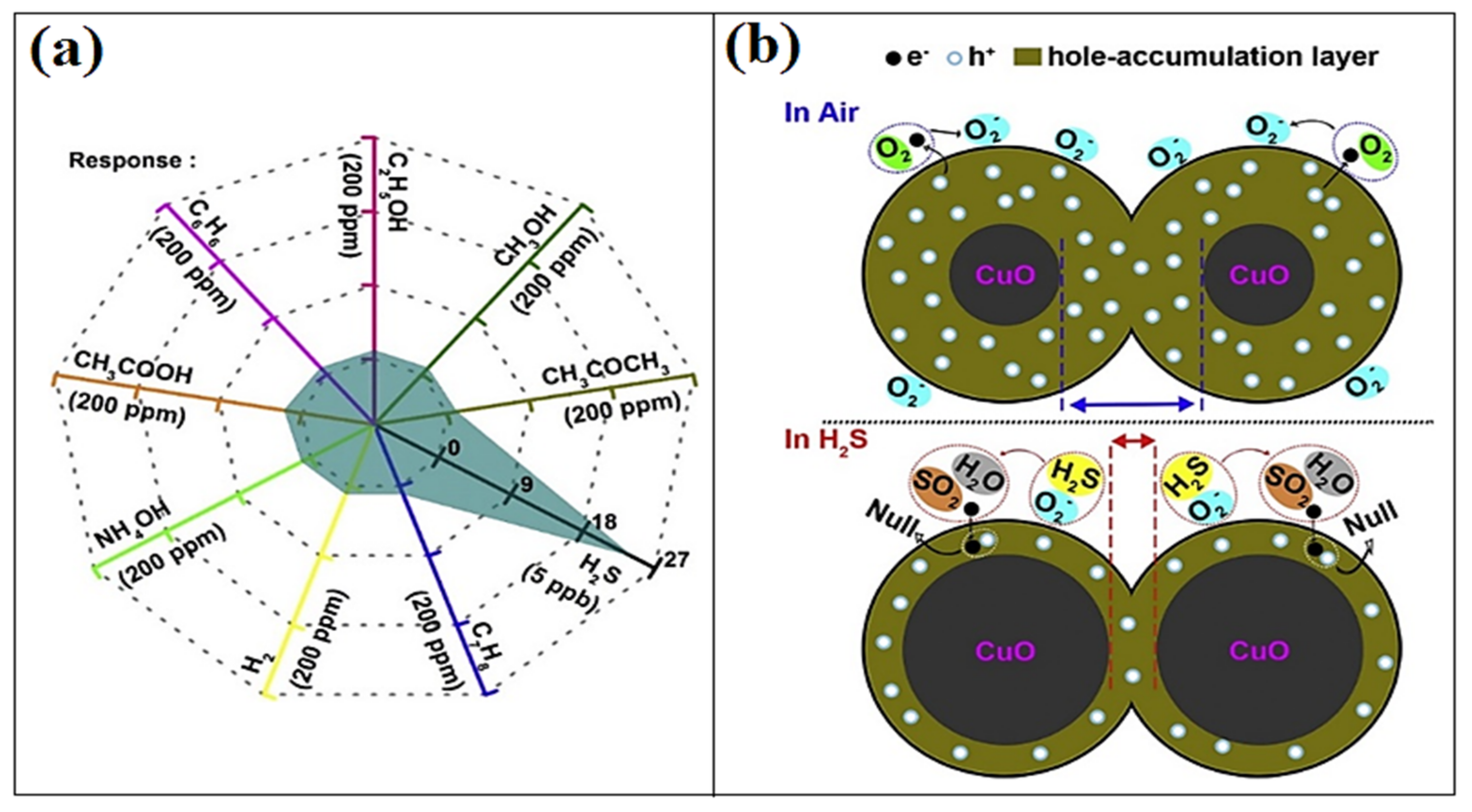
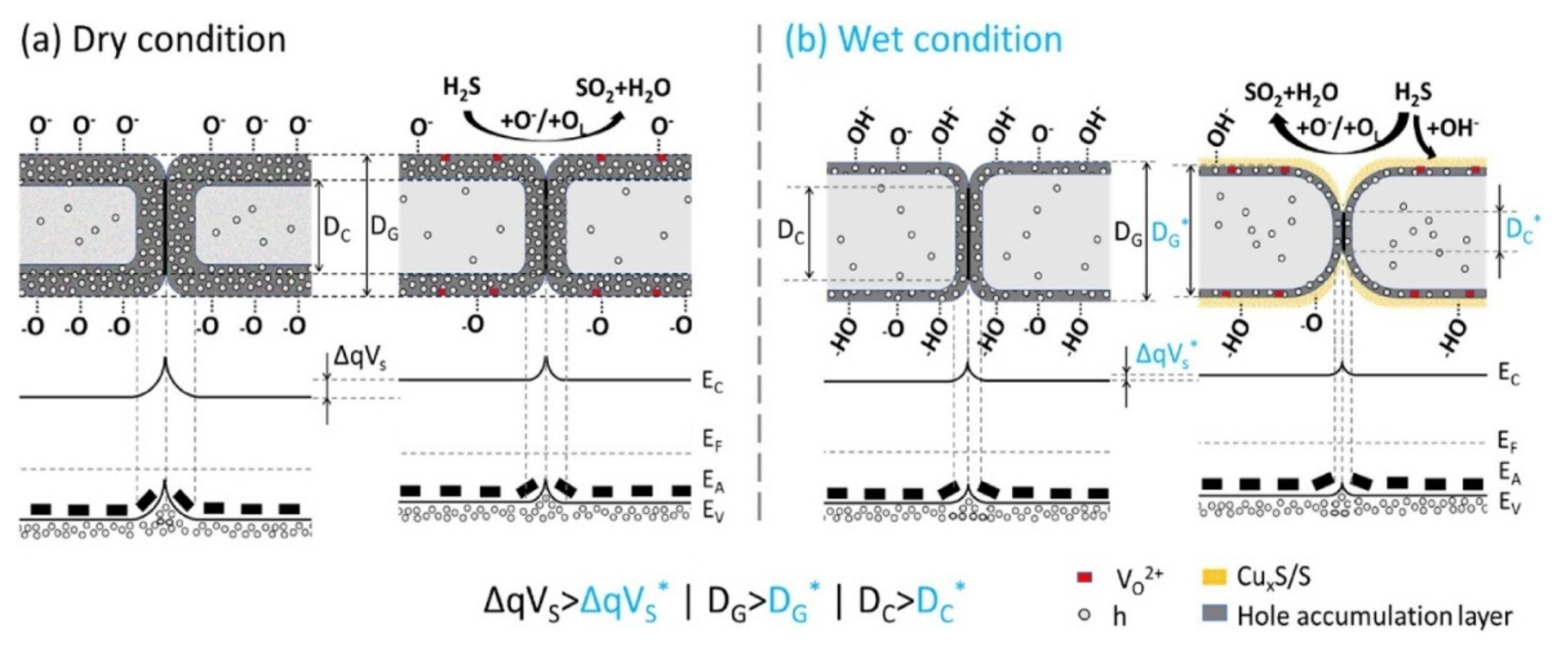

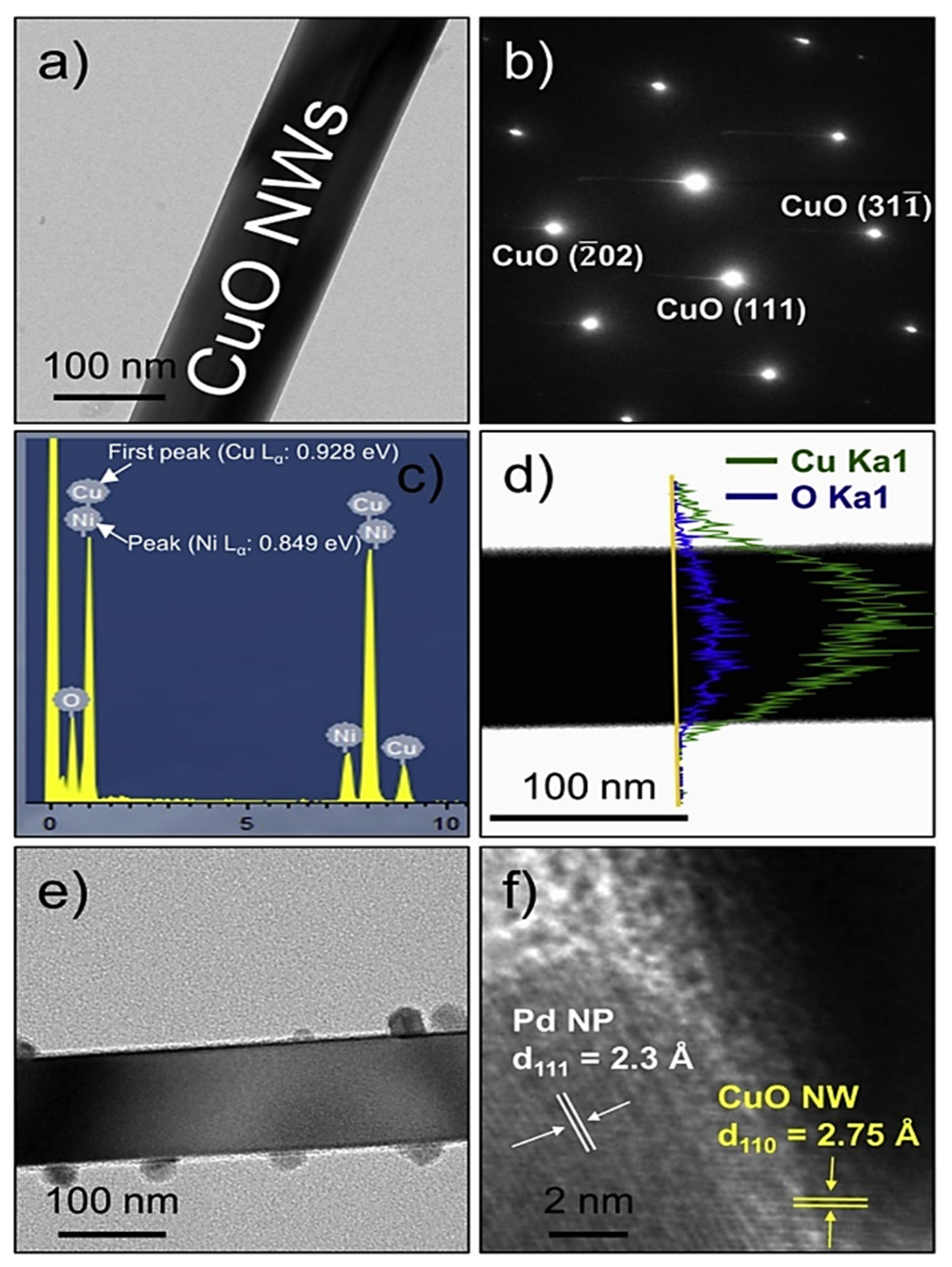
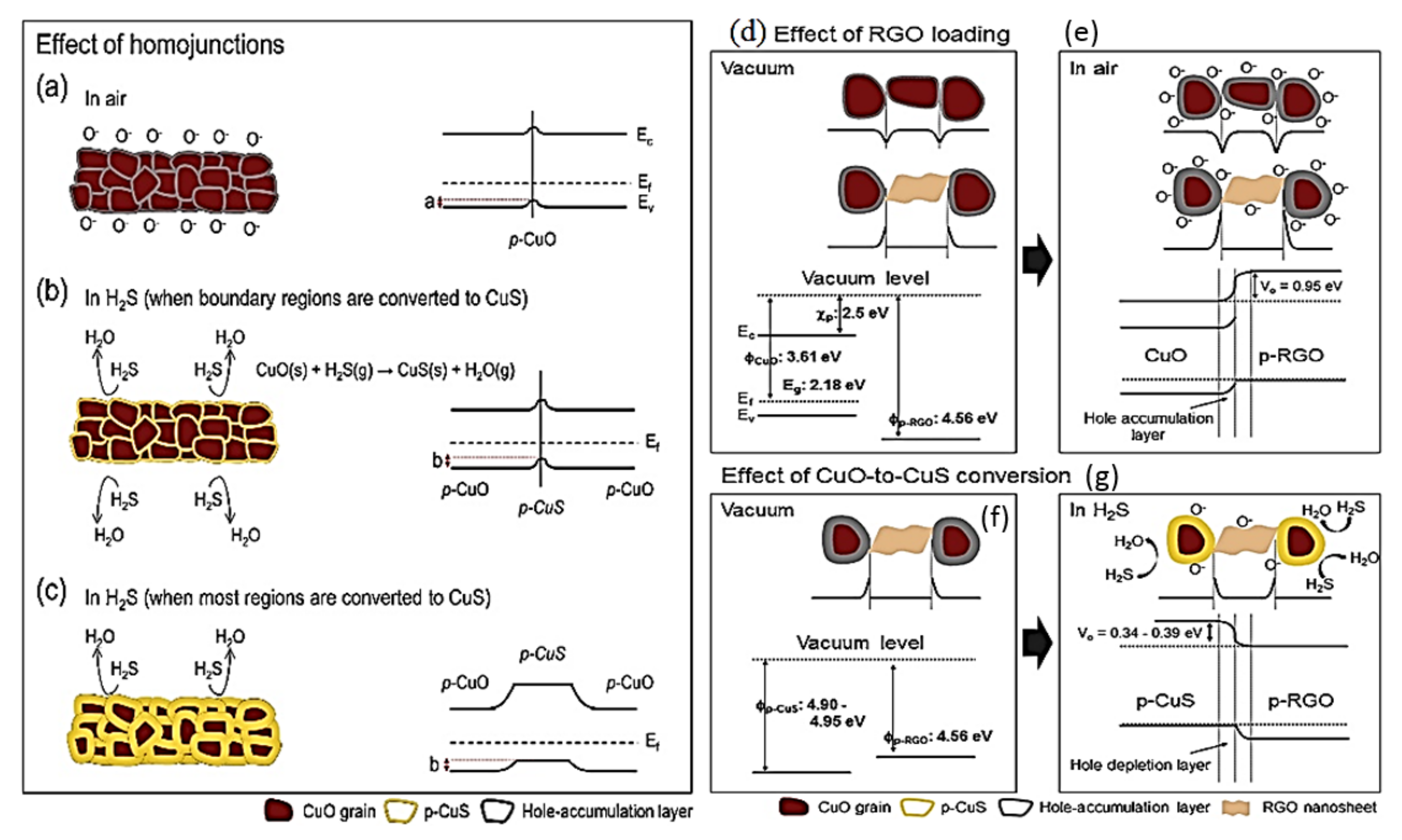


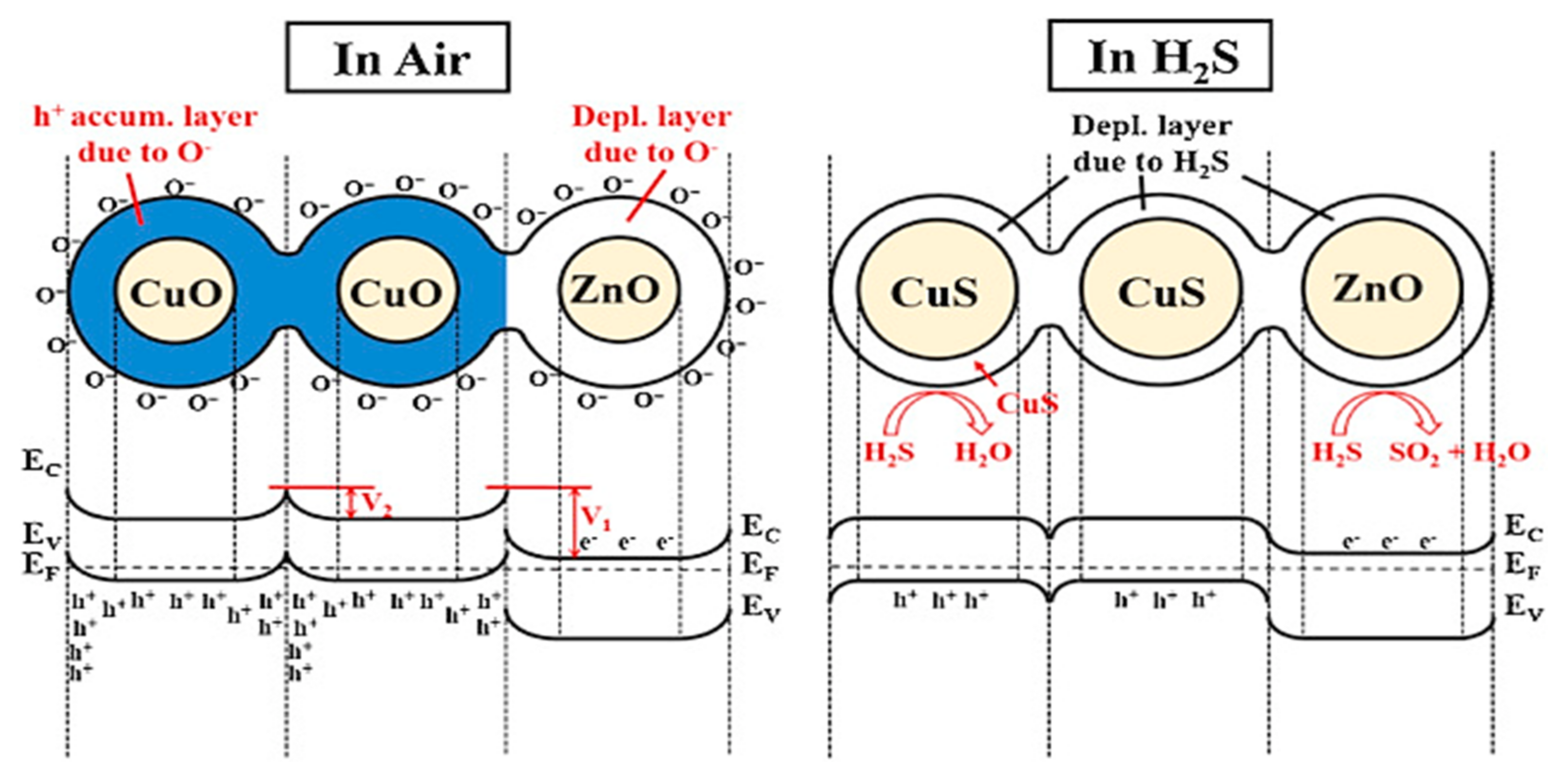

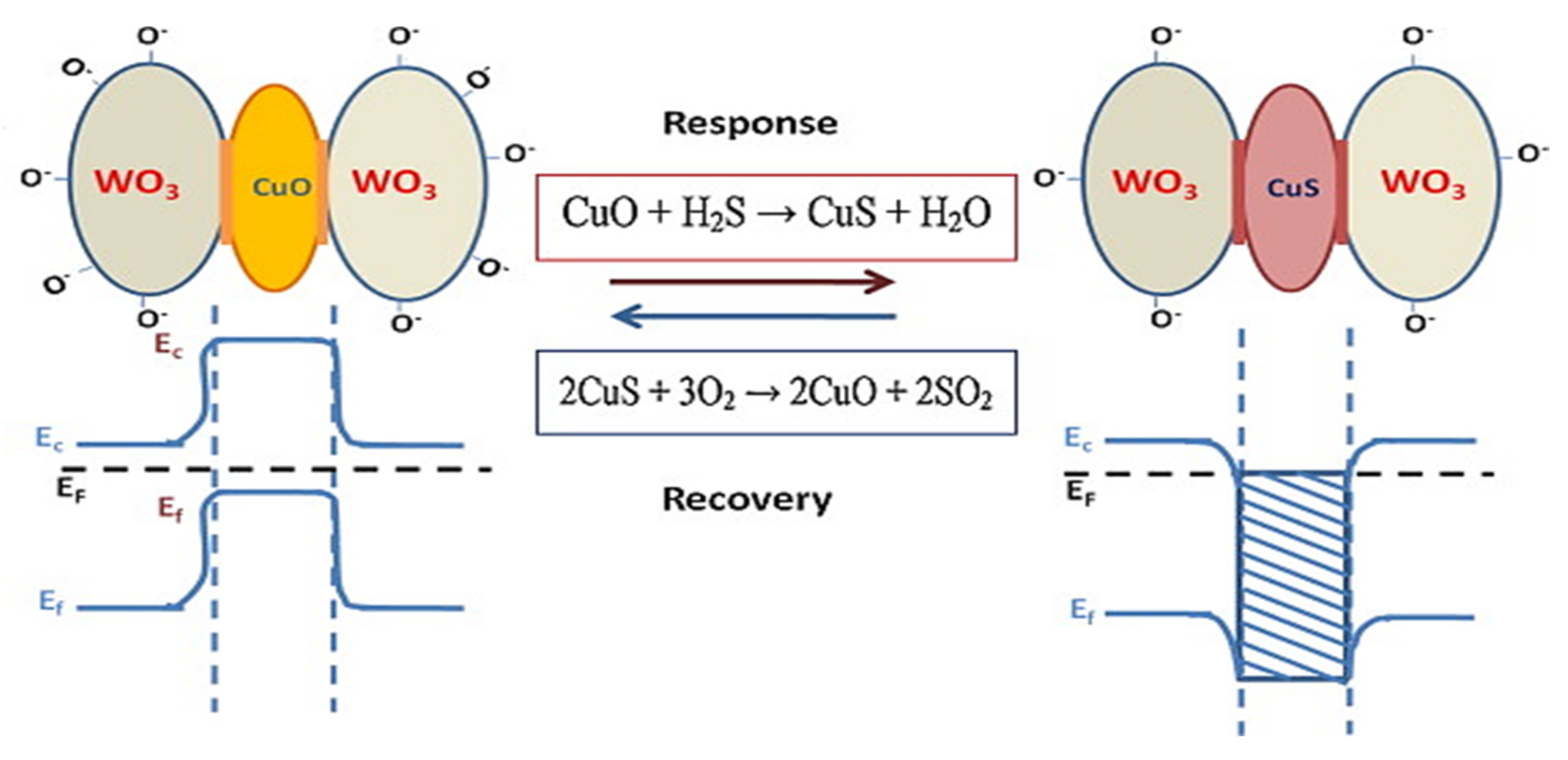


| Gas | Ammonia (NH3) | Hydrogen (H2) | Methane (CH4) | Carbon Monoxide (CO) | H2S |
|---|---|---|---|---|---|
| Bond | H‒NH2 | H‒H | H‒CH3 | C‒O | H‒SH |
| Bond Energy (kJ/mol) | 435 | 436 | 431 | 1076 | 381 |
| Molecular Size (nm) | 0.26 | 0.289 | 0.38 | 0.37 | 0.34 |
| Sensor | H2S Conc. (ppm) | Response (Rg/Ra) | LOD † (ppm) | Res. Time (s)/ Rec. Time (s) | T (°C) | Ref. |
|---|---|---|---|---|---|---|
| CuO nanoparticles | 5 | 4.9 ± 0.43 | 0.2 | 297.5 ± 9.2/54 ± 7.1 | 40 | [12] |
| CuO nanoneedles | 10 | 76.5% (ΔR/Ra) × 100 | 161 ppb | 92/196 | 150 | [37] |
| Sea anemone-like CuO nanoarrays | 5 ppb | 24.08 | 1.52 ppb | 102/539 | 25 | [38] |
| CuO nanosheets | 400 ppb | 1.7 | 3 ppb | NA * | 325 | [39] |
| CuO nanocuboids | 10 | ~2.4 (ΔR/Ra) | 1 | NA | 200 | [40] |
| CuO nanosheets | 1 | 325% [(ΔR/Ra) × 100] | 2 ppb | 4/9 | 240 | [41] |
| CuO nanowires | 100 ppb | ~0.2 (ΔR/Ra) | 2.5 ppb | 10 min/15 min | 180 | [42] |
| Sensing Materials | H2S Conc. (ppm) | Response (Rg/Ra) | LOD (ppm) | Res. Time (s)/ Rec. Time (s) | T (°C) | Ref. |
|---|---|---|---|---|---|---|
| Pd-decorated CuO NWs | 100 | 1.962 | 1 | NA | 100 | [27] |
| Pd-decorated CuO nanorods | 100 | 31,243%(ΔR/Ra) × 100 | 20 | 670/80 | 300 | [48] |
| Pd (1 mol.%)-loaded CuO nanocrystals | 8 | 7.9 | 1 | NA | 250 | [49] |
| Pd-doped CuO nanoflowers | 50 | 123.4 | 0.1 | 15/3500 | 80 | [50] |
| Sensing Materials | H2S Conc. (ppm) | Response (Rg/Ra) | LOD | Res. Time (s)/ Rec. Time (s) | Tempt. (°C) | Ref. |
|---|---|---|---|---|---|---|
| SnO2–CuO nanotubes | 5 | 1395 (Ra/Rg) | 1 | 5.27/NA | 200 | [57] |
| Bamboo-like CuO/In2O3 (3.5 wt.%) heterostructure | 5 | 229.3 | 200 ppb | 10/3600 | 70 | [61] |
| rGO-loaded CuO NFs | 10 | 11.7 | 1 | NA | 300 | [64] |
| CuO‒MoS2 | 30 | 61% (|Ra − Rg|/Ra × 100) | 1 ppb | 26/18 | 25 | [68] |
| ZnO/CuO nanotubes | 20 | 42% [(Rg − Ra/Ra) × 100] | 1 | 37/94 | 50 | [69] |
| CuO/V2O5 hybrid nanowires | 23 | 31.86 | 7 | 130/218 | 220 | [70] |
| CuO-functionalized SnO2–ZnO core–shell NWs | 10 | 2.5 | 1 | NA | 50 (5 V) | [76] |
| CuO/ZnO nanorods | 50 | ~890 [(Ig − Ia)/Ia] | 6.75 | ~900/NA | 500 | [77] |
| CuO‒ZnO composite | 2 | 1035% [(Rg/Ra) × 100] | 0.1 | 30/98 | 225 | [78] |
| MoO3–CuO nanocomposite | 5 | 7.9 (Ra/Rg) | 5 | NA | 100 | [79] |
| CuO-functionalized SnO2 NWs | 20 | 809 | 20 | 1/332 | 300 | [84] |
| CuO-loaded SnO2 hollow spheres | 1 | 3.14 (Ra/Rg) | 0.2 | NA | 300/80%RH | [86] |
| CuO-modified WO3 | 10 | 534 (Ra/Rg) | 2 | 5/24 min | 300 | [87] |
| ZnO/CuO nanocomposite | 10 | 393.35 | 300 ppb | 173/NA | 40 | [88] |
| CuO/NiO nanowall arrays | 5 | 36.9 | 0.5 ppb | 13/60 | 133 | [89] |
| CuO‒SnO2 NFs | 50 | 23.58 (Ra/Rg) | 1 | 105/152 | 180 | [90] |
| CNTs/SnO2/CuO composites | 40 | 19% (ΔR/Ra) × 100 | 10 | 4 min/10 min | 25 | [91] |
Publisher’s Note: MDPI stays neutral with regard to jurisdictional claims in published maps and institutional affiliations. |
© 2021 by the authors. Licensee MDPI, Basel, Switzerland. This article is an open access article distributed under the terms and conditions of the Creative Commons Attribution (CC BY) license (https://creativecommons.org/licenses/by/4.0/).
Share and Cite
Navale, S.; Shahbaz, M.; Majhi, S.M.; Mirzaei, A.; Kim, H.W.; Kim, S.S. CuxO Nanostructure-Based Gas Sensors for H2S Detection: An Overview. Chemosensors 2021, 9, 127. https://doi.org/10.3390/chemosensors9060127
Navale S, Shahbaz M, Majhi SM, Mirzaei A, Kim HW, Kim SS. CuxO Nanostructure-Based Gas Sensors for H2S Detection: An Overview. Chemosensors. 2021; 9(6):127. https://doi.org/10.3390/chemosensors9060127
Chicago/Turabian StyleNavale, Sachin, Mehrdad Shahbaz, Sanjit Manohar Majhi, Ali Mirzaei, Hyoun Woo Kim, and Sang Sub Kim. 2021. "CuxO Nanostructure-Based Gas Sensors for H2S Detection: An Overview" Chemosensors 9, no. 6: 127. https://doi.org/10.3390/chemosensors9060127
APA StyleNavale, S., Shahbaz, M., Majhi, S. M., Mirzaei, A., Kim, H. W., & Kim, S. S. (2021). CuxO Nanostructure-Based Gas Sensors for H2S Detection: An Overview. Chemosensors, 9(6), 127. https://doi.org/10.3390/chemosensors9060127









